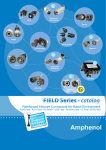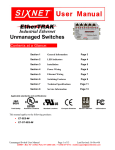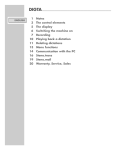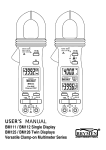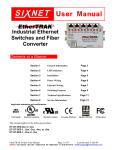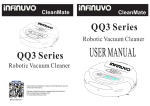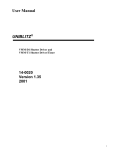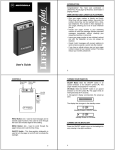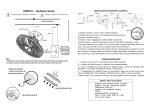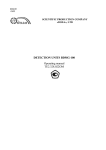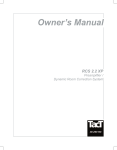Download Data Sheet
Transcript
Amphenol RJ-Switch Industrial Ethernet Unmanaged Switch - User Manual Contents Section 1 General Information Page 3 Section 2 LED Indicators Page 4 Section 3 Installation Page 5 Section 4 Power Wiring Page 6 Section 5 Ethernet Wiring Page 7 Section 6 Switching Features Page 9 Section 7 Technical Specifications Page 11 Section 8 Service Information Page 13 Applicable standards and certifications: Total Quality Hazardous Locations Standard Locations European Directives Marine & Offshore US Emissions This manual applies to the following products: • RJS-5ES Series – Unmanaged Ethernet switch with 5 ports 10/100 Mbps • RJS-9ES Series – Unmanaged Ethernet switch with 9 ports 10/100 Mbps Unmanaged Switch User Manual Page 1 of 13 Last Revised: 11-Jul-06 Amphenol – 948, Promenade de l‘Arve – B.P. 29 – 74311 THYEZ Cedex – France - +33(0)4.50.89.28.00 – www.rjswitch.com Amphenol Statement of Limited Warranty: The characteristics of the Products shall be defined as those published in the most recent version of the Vendor's specifications, unless different characteristics are expressly agreed between the Vendor and the Customer. Unless expressly agreed to the contrary, the guarantee shall be valid for one year from the date of delivery. The guarantee shall be made invalid: • Where the components have been damaged in transit or have not been stored by the Customer in conditions in accordance with the specification. • Where the components have been subjected to abuse (mechanical, electrical or thermal) on installation or on use and, in the case of slices/dice, have been subjected to handing or such operations as the welding of connecting wires mounting by soldering or sticking. • Where the unfitness or defectiveness of the components has resulted from exceeding the maximum values for usage (temperature limit, maximum voltage, etc.) as defined by the Vendor, or from incorrect choice of application. Furthermore, the guarantee shall not cover consequential liability, direct or indirect which may result from the failure of a component supplied by the Vendor. The foregoing constitutes the Vendor's guarantee in its entirely and takes the place of any other format guarantee, implied or otherwise. The guarantee is limited, at the Vendor's option, to either the replacement or the repair of the component accepted by him as being defective, to the exclusion of any other from of compensations. INSTALLATION AND HAZARDOUS AREA WARNINGS: These products should not be used to replace proper safety interlocking. No software-based device (or any other solid-state device) should ever be designed to be responsible for the maintenance of consequential equipment or personnel safety. In particular, Amphenol disclaims any responsibility for damages, either direct or consequential, that result from the use of this equipment in any application. All power, input and output (I/O) wiring must be in accordance with Class I, Division 2 wiring methods and in accordance with the authority having jurisdiction. WARNING (EXPLOSION HAZARD) - SUBSTITUTION OF COMPONENTS MAY IMPAIR SUITABILITY FOR CLASS 1, DIVISION 2. WARNING (EXPLOSION HAZARD) - WHEN IN HAZARDOUS LOCATIONS, DISCONNECT POWER BEFORE REPLACING OR WIRING UNITS. WARNING (EXPLOSION HAZARD) - DO NOT DISCONNECT EQUIPMENT UNLESS POWER HAS BEEN SWITCHED OFF OR THE AREA IS KNOWN TO BE NONHAZARDOUS. FCC Statement: This equipment has been tested and found to comply with the limits for a Class B digital device, pursuant to Part 15 of the FCC Rules. These limits are designed to provide reasonable protection against harmful interference in a residential installation. This equipment generates, uses and can radiate radio frequency energy and, if not installed and used in accordance with the instructions, may cause harmful interference to radio communications. However, there is no guarantee that interference will not occur in a particular installation. If this equipment does cause harmful interference to radio or television reception, which can be determined by turning the equipment off and on, the user is encouraged to try to correct the interference by one or more of the following measures: Reorient or relocate the receiving antenna; Increase the separation between the equipment and receiver; Connect the equipment into an outlet on a circuit different from that to which the receiver is connected; Consult the dealer or an experienced radio/TV technician for help. Copyright & Trademarks: Copyright © Amphenol, All Rights Reserved. Note: All information in this document is subject to change without notice. Unmanaged Switch User Manual Page 2 of 13 Last Revised: 11-Jul-06 Amphenol – 948, Promenade de l‘Arve – B.P. 29 – 74311 THYEZ Cedex – France - +33(0)4.50.89.28.00 – www.rjswitch.com Section 1 Overview Operation General Information This manual will help you install and maintain the Amphenol Industrial Ethernet Unmanaged switches. These products are extremely easy to install and operate because little or no user configuration is required. Once the Ethernet connections are made and the unit is powered up it will immediately begin to operate. Unlike an Ethernet hub that broadcasts all messages out all ports, these witches will intelligently route Ethernet messages only out the appropriate port. The major benefits of this are increased bandwidth and speed, reduction or elimination of message collisions, and deterministic performance when tied with Unmanaged systems. These switches support both 10BaseT (10 Mbps) and 100BaseTx (100 Mbps) on their RJ45 ports. Each of these ports will independently auto-sense the speed, allowing you to interface to regular or fast Ethernet devices. Some models also have 100BaseFX (100 Mbps) fiber optic port(s). Refer to Section 6 for more information on operation and features. Performance Specifications Standards and Safety These general specifications apply to these switches. Refer to Section 7 for complete technical specifications. Ports (models vary) 10/100BaseT(x) (Shielded RJ45), 100BaseFX (SC or ST connectors) Required Voltage 10 - 30 VDC (see Section 7 for power consumption for each model) Ethernet Standards IEEE 802.3 (10BaseT), 802.3u (100BaseTX), 802.3x (Full Duplex) Ethernet Protocols All standard IEEE 802.3 protocols supported Speed Per Port RJ45: 10 Mbps (half duplex) or 200 Mbps (full duplex) Fiber: 100 Mbps (half duplex) or 200 Mbps (full duplex) Ethernet Isolation 1500 Volts RMS (for 1 minute) Operating Temp. -40 to 85 °C Humidity 5 to 95% (non-condensing) Screw Terminals 14 AWG max. (tighten to 3.48 in-lbs. max.) The Amphenol Industrial Ethernet Switch meets the following standards: Electrical safety - UL 508, CSA C22/14; EN61010-1 (IEC1010) EMI emissions - FCC part 15, ICES 003, EN55022; Class B EMC immunity – EN61326-1 (EN61000-4--2, 3, 4, 5 and 6) Hazardous locations – UL 1604, CSA C22.2/213 (Class 1, Div. 2), Groups A, B, C, D; Cenelec EN50021 (Zone 2) EEx nA II T4 X (-40°C ≤ Ta ≤ +85°C) Install the Amphenol Industrial Ethernet Switch in accordance with local and national electrical codes. Lightning Danger: Do not work on equipment during periods of lightning activity. Do not connect a telephone line into one of the Ethernet RJ45 connectors. Unmanaged Switch User Manual Page 3 of 13 Last Revised: 11-Jul-06 Amphenol – 948, Promenade de l‘Arve – B.P. 29 – 74311 THYEZ Cedex – France - +33(0)4.50.89.28.00 – www.rjswitch.com Section 2 Overview LED Indicators These switches have communication LEDs for each port and a power LED. Refer to the pictures below for the typical location of these LEDs. The exact location of these LEDs may vary between the different models. RJS-5ES-1 (5 port – all RJ45) Power LED ACT / LNK LEDs RJS-5ES-2 or -3 ( 5 ports including 1 fiber) RJS-9ES-1 (9 ports – all RJ45) This LED will be on solid when proper power has been applied to the unit. The activity (ACT) and link (LNK) indication is combined into one LED (labeled “ACT/LNK” or “A”) on these switches. There is one of these LEDs per port. OFF – This would indicate that there is not a proper Ethernet connection (Link) between the port and another Ethernet device. Make sure the proper cable type is in use and that it has been plugged securely into the ports at both ends. See section 5 for proper Ethernet cabling. ON Solid (not flashing) – This would indicate that there is a proper Ethernet connection (Link) between the port and another Ethernet device, but no communications activity is detected. Flashing – This would indicate that there is a proper Ethernet connection (Link) between the port and another Ethernet device, and that there is communications activity. 10 / 100 LEDs This LED indicates what speed of communications is detected on the port. There is one of these LEDs per RJ45 port and it is labeled “S”. (The fiber optic port does not have one of these LEDs because its speed is fixed at 100 Mbps.) (Mbps = Megabits per Second) OFF – A 10 Mbps (10BaseT) connection is detected. ON – A 100 Mbps (100BaseTx) connection is detected. Unmanaged Switch User Manual Page 4 of 13 Last Revised: 11-Jul-06 Amphenol – 948, Promenade de l‘Arve – B.P. 29 – 74311 THYEZ Cedex – France - +33(0)4.50.89.28.00 – www.rjswitch.com Section 3 Installation All switches share the same footprint and can be snapped onto a standard DIN rail (EN50022) or screwed directly to a flat panel. Refer to the mechanical drawing below. Note: The Ethernet connections for the ET-5ES-1 come out the face of the unit. The Ethernet connections for all other models come out the top. Make sure to allow enough room to route your Ethernet cables. Overview ST Fiber 0.40" [1.02 cm] (max. for ST Fiber) 8 or 9 Copper Ports (RJ45) SC Fiber 0.275" [0.70 cm] 0 or 1 Fiber Port (SC or ST) 3.17" [8.05 cm] 2.935" [7.45 cm] DIN EN 50022 (not included) Front View 0.235" [0.60 cm] ET-GT-9ES Series 0.17" [0.43] (clear for #8 screw) B 1.60" [4.07 cm] Power 4.475" [11.37 cm] 4.75" [12.07 cm] 5 Port Model – Side View Side View 5 port model with no fiber: A=1.20" [3.05 cm]; B=0.55" [1.40 cm] DIN EN50022 (not included with units; not shown to scale; for reference only) 5 port model with single fiber: A=1.20" [3.05 cm]; B=0" [0 cm] A 1.38" [3.5 cm] 5 port model with dual fiber: A=1.95" [4.95 cm]; B=0.35" [0.90 cm] 1.06" [2.7 cm] B A 1.38" [3.5 cm] 9 Port Model – Side View Side View Version 1.## units (prior to 11/04): A=1.65" [4.19 cm]; B=0.85" [2.16 cm] 0.30" [0.76 cm] DIN EN50022 (not included with units; not shown to scale; for reference only) Version 2.## units (after 11/04): A=1.95" [4.95 cm]; B=0.35" [0.90 cm] 1.06" [2.7 cm] Unmanaged Switch User Manual Page 5 of 13 0.30" [0.76 cm] Last Revised: 11-Jul-06 Amphenol – 948, Promenade de l‘Arve – B.P. 29 – 74311 THYEZ Cedex – France - +33(0)4.50.89.28.00 – www.rjswitch.com Section 4 Power Wiring These switches can be powered from the same DC source that is used to power your I/O devices. 10 to 30 VDC needs to be applied to terminals 2 and 3. Optionally, on the 5ES models a backup power supply may be connected. Refer to the wiring diagram below. Terminal 1 should be tied to panel or chassis ground. Overview Redundant DC Power Single DC Power P1 P2 P1 To Panel P2 + + - To Panel + - To Panel + - VDC Supply + VDC Supply VDC Supplies Single or Dual Power Inputs for 5ES Model Screw Torque DC Power Single Power Input for 9ES Model The screw terminals should be tightened as follows: Maximum 3.48 in-lbs (0.4 Nm) Unmanaged Switch User Manual Page 6 of 13 Last Revised: 11-Jul-06 Amphenol – 948, Promenade de l‘Arve – B.P. 29 – 74311 THYEZ Cedex – France - +33(0)4.50.89.28.00 – www.rjswitch.com Section 5 Overview Ethernet Wiring These switches provide connections to Ethernet devices on the factory floor. Typically a port is used to connect to another Ethernet switch or hub that is connected to the main Ethernet backbone. The other Ethernet ports are then connected to Ethernet devices such as PLCs, Ethernet I/O, or industrial computers. Electrical isolation is provided on the Ethernet ports for increased reliability. Please follow normal Ethernet wiring practices when installing these switches. Typical Amphenol Industrial Ethernet Switch Installation Refer to the Amphenol On-line Catalog for More Usage Ideas Note: All 5 ports on the 5-port switch and ports 1-8 on the 9-port switch support auto-speed & duplex detection, auto-mdi/mdix-corssover and auto-polarity. Port 9 is an uplink port and will auto-speed and crossover detect but require full duplex and the correct polarity. RJ45 Wiring Guidelines Ethernet Cable Pin-outs Use data-quality (not voice-quality) twisted pair cable rated category 5 (or better) with standard RJ45 connectors. For best performance use shielded cable. Please note that these cables are available as straight-thru or cross-over configurations. Either type can be used because these switches support auto-mdi/mdix-crossover. For reference, the pin-outs of the two cable types are listed below. Straight-thru Cable Wiring Pin 1 Pin 1 Pin 2 Pin 2 Pin 3 Pin 3 Pin 6 Pin 6 Cross-over Cable Wiring Pin 1 Pin 3 Pin 2 Pin 6 Pin 3 Pin 1 Pin 6 Pin 2 Ethernet Connector Pin Positions Unmanaged Switch User Manual Page 7 of 13 Last Revised: 11-Jul-06 Amphenol – 948, Promenade de l‘Arve – B.P. 29 – 74311 THYEZ Cedex – France - +33(0)4.50.89.28.00 – www.rjswitch.com Ethernet Connector Pin-outs Cable Distance Pin # MDI-X Port 1 2 3 6 TX+ TXRX+ RX- MDI Port (typical for uplink) RX+ RXTX+ TX- AutoMDI/ MDI-X TX/RX+ TX/RXRX/TX+ RX/TX- Ethernet Device Port RX+ RXTX+ TX- The maximum cable length for 10/100BaseT(x) is typically 100 meters (328 ft.). From Switch Switch or Hub To Switch or Hub PLC, Ethernet I/O, PC, etc. Maximum Distance 100 meters (328 feet) 100 meters (328 feet) Note: Hubs and switches are different devices. Hubs simply broadcast all messages out all ports. switches intelligently route messages only out the appropriate port Ethernet Fiber Wiring Guidelines These switches may have one or two pair of fiber ports of the type multimode or singlemode. Multimode ports support a maximum segment length of 2 km. Singlemode ports support a maximum segment length of 15 km, 40 km (long haul models) or even more (contact Amphenol.) Each fiber optic port on the switch is comprised of a pair of SC or ST connectors, which are labeled with “RX” and “TX” on the switch. When making your fiber optic connections, make sure that the transmit (TX) port of the switch connects to the receive (RX) port of the other device, and the receive (RX) port of the switch connects to the transmit (TX) port of the other device. The ACT/LNK LED will be ON solid when you have made a proper connection. Full or Half Duplex Operation The RJ45 ports will auto-sense for Full or Half duplex operation. No user configuration is necessary. Each fiber optic port has a movable slide-switch or jumper that allows you to select the mode. The metal cover needs to be removed to access the movable jumper. See diagram below. Note: You must cycle power to the switch after changing the slideswitch or jumper position. Unmanaged Switch User Manual Page 8 of 13 Last Revised: 11-Jul-06 Amphenol – 948, Promenade de l‘Arve – B.P. 29 – 74311 THYEZ Cedex – France - +33(0)4.50.89.28.00 – www.rjswitch.com Section 6 Switching Features Switching Features Here’s a brief explanation of some of the features found in these switches documented by this manual. 10BaseT and 100BaseTx Auto-detection Standard Ethernet (10BaseT) has a maximum speed of 10 Mbps in half duplex mode. Fast Ethernet (100BaseTx) has a maximum speed of 200 Mbps in full duplex mode. The RJ45 ports on these switches automatically select the appropriate speed. 100BaseFX (multimode and singlemode) fiber optic port The fiber optic port found on some models is classified as 100BaseFX and supports 100 Mbps operation only. Both multimode and singlemode models are available. Multimode allows for multiple wavelengths over a cable with a core diameter of typically 50 or 62.5 microns. The maximum distance for multimode is 2 km. Singlemode uses a single wavelength and cable core diameter of around 10 microns which allows for a maximum distance of 15 km, 40 km or more (contact Amphenol for longer distances). 3.2 Gbps combined bandwidth With full duplex and 100BaseTX or 100BaseFX communications, each port can provide a full 200 Mbps of data throughput. 1K MAC addresses with automatic learning, aging and migration Each Ethernet device inserts its unique “MAC” address into each message it sends out. The port on the switch used for a given MAC address is automatically learned when a frame is received from that address. Once an address is learned, the switch will route messages to only the appropriate port, instead of broadcasting messages out all ports like a hub. A time stamp is also placed in memory when a new address is learned. This time stamp is used with the aging feature, which will remove unused MAC addresses from the table after 300 seconds. If a device moves, the associated port on the switch will be changed (migrated) as needed. Up to 1,024 MAC addresses can be stored and monitored at any time. Auto-crossover (auto-mdi/mdi-x) The RJ45 ports will automatically detect the cable type (straight-thru vs. cross-wired) and re-configure themselves accordingly. Auto-polarity The RJ45 ports (except port 9) will automatically correct for reversed polarity on the TD and RD pair. Auto-sensing or auto-negotiating speed The RJ45 ports of these switches will auto-negotiate with the connected device to determine the optimal speed (10 Mbps vs. 100 Mbps). Automatic power saving If there is no cable on a port, most of the circuitry for that port is disabled to save power. Back pressure for half-duplex The Amphenol Industrial Ethernet Switch will apply “back pressure” when necessary with half-duplex operation. This “back pressure” will reduce congestion on busy networks. Buffering SRAM is used for buffering the messages. The 5ES switches have ½ Mbits (64 Kbytes) while the 9ES switches have 1 Mbits (128 Kbytes). The buffer size is automatically allocated for each port as necessary. Unmanaged Switch User Manual Page 9 of 13 Last Revised: 11-Jul-06 Amphenol – 948, Promenade de l‘Arve – B.P. 29 – 74311 THYEZ Cedex – France - +33(0)4.50.89.28.00 – www.rjswitch.com Unmanaged operation These switches require no supervisory processor to operate properly. Flow control These switches automatically support flow control frames on both the transmit and receive sides. Back-pressure flow control for half-duplex ports and pause-frame flow control for full-duplex ports. Forwarding These switches support store and forward mode. They will forward messages with known addresses out only the appropriate port. Messages with unknown addresses, broadcast messages, and multicast messages will get forwarded out all ports except the source port. Full / Half duplex operation The RJ45 ports (except port 9, which is full duplex only) of these switches support both full and half duplex flow control. The fiber optic port(s) has a settable jumper or switch, which allows you to select the desired operation. Illegal frames Illegal frames as defined by IEEE 802.3 will be dropped. This includes short frames, long frames, CRC error frames and alignment error frames. IEEE 802.3 compliant The Amphenol Industrial Ethernet Switch strictly abides to the IEEE 802.3 standard for 10BaseT, 100BaseTX, and 100BaseFX Ethernet communications. Latency The typical latency of a message at 100 Mbps is 5 microseconds or faster. The latency is the time it takes a message to be routed internal to a switch from one port to another. Non-blocking This means that the switches offer the best in performance and are capability of full-wire speed transmissions. Plug and play This means that most functions or features of these switches are automatic and that there are minimal or no optional parameters that need to be set. Just plug in your Ethernet cables, apply power, and the unit will immediately begin to operate. Protocol independent These switches will work with all popular Ethernet protocols and networks such as TCP/IP, the Internet (IP), UDP, NetBEUI, and many more. It is compatible with all protocols that run over standard Ethernet (IEEE 802.3). In fact, it will support packets of different protocols simultaneously. Unmanaged Switch User Manual Page 10 of 13 Last Revised: 11-Jul-06 Amphenol – 948, Promenade de l‘Arve – B.P. 29 – 74311 THYEZ Cedex – France - +33(0)4.50.89.28.00 – www.rjswitch.com Section 7 Technical Technical Specifications Here are the technical specifications for these switches covered by this manual. Specifications Copper Ports: (10/100BaseTx) 10/100BaseT(x) ports Protocols supported Ethernet compliancy Auto-crossover Auto-negotiating Auto-polarity Flow control Ethernet isolation Plug and play Cable requirements Max. cable distance Shielded RJ45 All standard IEEE 802.3 IEEE 802.3, 802.3u, 802.3x Yes , Auto-mdi/mdix-crossover 10BaseT or 100BaseTX Yes (except port 9) Half or full duplex (port 9 is full duplex only) 1500 VRMS 1 minute Yes Twisted pair (Cat. 5 or better) (shielded recommended) 100 meters Multimode Fiber Port: (100BaseFX) Fiber port mode Fiber port connector Optimal fiber cable Center wavelength TX output power RX input sensitivity Maximum distance Half and full duplex Ethernet compliance Eye safety Multimode Duplex SC or ST 50/125, 62.5/125 µm 1300 nm Contact Amphenol for optical details. 4 km (see web or details) Switch or jumper selectable 100BaseFX IEC 60825-1, Class 1; FDA 21 CFR 1040.10 and 1040.11 Singlemode Fiber Port: (100BaseFX) Fiber port mode Fiber port connector Optimal fiber cable Center wavelength TX output power RX input sensitivity Maximum distance Half and full duplex Ethernet compliance Eye safety Unmanaged Switch User Manual Singlemode Duplex SC or ST 9/125, 10/125 µm 1300 nm Contact Amphenol for optical details. 20 km, 40 km (long haul models) or more (contact Amphenol) Switch or jumper selectable 100BaseFX IEC 60825-1, Class 1; FDA 21 CFR 1040.10 and 1040.11 Page 11 of 13 Last Revised: 11-Jul-06 Amphenol – 948, Promenade de l‘Arve – B.P. 29 – 74311 THYEZ Cedex – France - +33(0)4.50.89.28.00 – www.rjswitch.com General: Operation Compliance Latency (typical) Memory bandwidth MAC addresses Address learning Address aging Address migration Back pressure Buffer memory Buffers per port & buffer size Illegal frames Flow control Unmanaged, Store and forward, non-blocking IEEE 802.3 (10BaseT), 802.3u (100BaseTX), 802.3x (Flow Control) 5 usec (time to route a message from one port to another internal to switch) 3.2 Gbps 1K (1024) Automatic Remove old address after 300s Automatic Automatic for half-duplex 64KB (5ES models) or 128KB (9ES models) Automatic and dynamic Dropped per 802.3 Yes, for half and full duplex Environmental: Required supply voltage Power consumption (typical); (Max. 8 Watts) (Note: Power consumption varies on speed and amount of activity of each port.) Power saving Max. screw terminal torque and wire gauge Operating temp. range Storage temp. range Humidity Flammability Electrical safety EMI emissions EMC immunity and surge withstand Vibration Hazardous locations Marine and offshore Dimensions Mounting Unmanaged Switch User Manual 10 – 30 VDC 5ES-1: 4.0 Watts 5ES-2/3: 5.0 Watts 5ES-4/5: 6.0 Watts 9ES-1: 6.0 Watts 9ES-2/3: 7.0 Watts Automatic 3.48 in-lbs (0.4 Nm), 14 AWG -40 to 85 °C -40 to 85 °C 5 to 95 % (non-condensing) UL 94V-0 materials UL508, CSA C22/14; EN61010-1 (IEC1010), CE FCC part 15, ICES 003, EN55022; Class B; CE EN61326-1 (EN61000-4-2, 3, 4, 5, 6), IEEE-472 (ANSI C37.90), CE IEC68-2-6 UL1604, CSA C22.2/213 (Class 1, Div. 2), Cenelec EN50021 (Zone 2) DNV tested See mechanical diagrams DIN rail or panel direct Page 12 of 13 Last Revised: 11-Jul-06 Amphenol – 948, Promenade de l‘Arve – B.P. 29 – 74311 THYEZ Cedex – France - +33(0)4.50.89.28.00 – www.rjswitch.com Section 8 Service Information Service Information We sincerely hope that you never experience a problem with any Amphenol product. If you do need service, call Amphenol at +33(0) 450 89 28 00 and ask for Applications Engineering. A trained specialist will help you to quickly determine the source of the problem. Many problems are easily resolved with a single phone call. If it is necessary to return a unit to us, an RMA (Return Material Authorization) number will be given to you. Amphenol tracks the flow of returned material with our RMA system to ensure speedy service. You must include this RMA number on the outside of the box so that your return can be processed immediately. The applications engineer you are speaking with will fill out an RMA request for you. If the unit has a serial number, we will not need detailed financial information. Otherwise, be sure to have your original purchase order number and date purchased available. We suggest that you give us a repair purchase order number in case the repair is not covered under our warranty. You will not be billed if the repair is covered under warranty. Please supply us with as many details about the problem as you can. The information you supply will be written on the RMA form and supplied to the repair department before your unit arrives. This helps us to provide you with the best service, in the fastest manner. Normally, repairs are completed in two days. Sometimes difficult problems take a little longer to solve. We apologize for any inconvenience that the need for repair may cause you. We hope that our rapid service meets your needs. If you have any suggestions to help us improve our service, please give us a call. We appreciate your ideas and will respond to them. For Your Convenience: Please fill in the following and keep this manual with your Amphenol system for future reference: P.O. #:__________________ Date Purchased: ___________________ Purchased From:______________________________________________ Product Support To obtain support for Amphenol products: Visit our website. http.//www.rjswitch.com Phone: +33(0) 450 89 28 00 Fax: +33(0) 450 96 29 75 E-mail: mailto:[email protected] Mailing Address: Amphenol, Promenade de l’Arve, B.P.29, 74311 Thyez Cedex, France For more information You will find all useful information on the RJ-Switch series on the dedicated website: http://www.rjswitch.com Unmanaged Switch User Manual Page 13 of 13 Last Revised: 11-Jul-06 Amphenol – 948, Promenade de l‘Arve – B.P. 29 – 74311 THYEZ Cedex – France - +33(0)4.50.89.28.00 – www.rjswitch.com Mouser Electronics Authorized Distributor Click to View Pricing, Inventory, Delivery & Lifecycle Information: Amphenol: RJS5MS1















